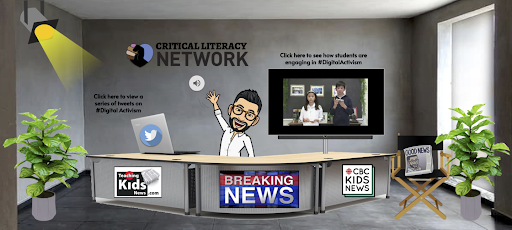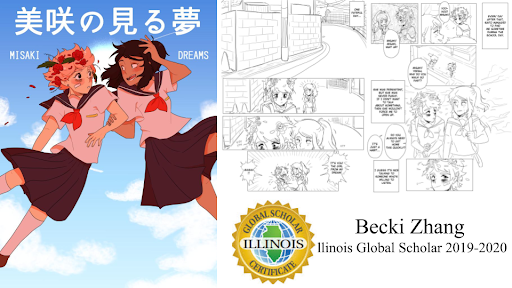
In whatever form they take, youth media can provide an accessible and relatable creative pathway through which students can experience different points of view and narratives, grapple with complex issues, and discover new ways to use their voices to inspire action on issues they care about.
In November 2021, as part of the Reinvent the Classroom program in partnership with HP and Microsoft, Digital Promise hosted a panel of educators who shared their perspectives and strategies for incorporating media literacy and production in the classroom.
Living on an island community in Alaska, Laura Davies, who teaches science, technology, math, and art at Stikine Middle School, was drawn to youth media as a powerful tool for her students to share their culture with other communities around the world. In one recent project, Davies’ students used FlipGrid videos and QR codes to share timelines about Alaskan civil rights leader Elizabeth Peratrovich with their local museum and students in other communities. In another project, students shared what they had learned in their Tlingit language class with peers in Taiwan to pass on their knowledge of Tlingit vocabulary.
Laura emphasizes the concept of “quality over quantity” to ensure students are focusing on their progress instead of their shortcomings. “I teach middle school, so I feel that is an age where we start to get self-conscious a little bit more compared to when we were doing this in fifth grade. Students often want to have in their eyes what the perfect product is going to be, and that’s really hard to achieve. One thing I started to really stress is, ‘is your product professional, did you strive to be professional rather than striving for perfection?’” explained Davies.

Students in Maple, Ontario, share media and perspectives with a real world audience.
Prior to becoming an educator, Robert Cannone, a K-8 coach and consultant in Maple, Ontario, Canada, was a television reporter and producer. In that role, Robert discovered the value of creating compelling stories to inform, inspire, and provoke action, and he now applies that same philosophy to support students as media makers. “We all know that youth are surrounded by media; we live in a media saturated world,” said Cannone. “What inspired me to get started with youth media is listening to my students whose interests were media, whose questions stemmed from media that they use day in and day out. I came to learn that when our students make media, they come to understand the nuances of the medium, the power of ideas to inform and shape thoughts, and the necessity to be critical.”
A bi-weekly news broadcast is just one example of how Cannone has helped his students hone both their media literacy and design thinking skills. “Through their interviews with others, they developed compassion, humility, and an understanding of how best to tell those stories,” explained Cannone. “They viewed the stories that were shared with them as a gift, and they needed to determine, through which lens am I going to tell this story? This required active listening skills, not interjecting with their story, but again centering the interview.”

Students in Maple, Ontario, share media and perspectives with a real world audience.
Reflecting on his own experience as a student, David Hoang, special education resource teacher and librarian at LC3 Virtual School / John A. Leslie Public School in Toronto, Ontario, Canada, recalled the impact of a teacher giving him access to a DSLR camera for the first time. “It became this powerful tool and catalyst to engage in things that I normally wouldn’t do,” described Hoang. Now, any time Hoang has the opportunity, he finds a way to embed photography or digital media to ensure his students have the opportunity to use the tools and technology available to them to empower their voices.
When COVID-19 necessitated virtual learning, Hoang’s students found themselves without access to the types of tools they had at school. In response, Hoang leaned into the possibilities of working with everyday accessible devices and technologies. Encouraging his students to “pick any sort of device or technology that you have and let’s make it work,” Hoang taught the fundamentals of photography, and connected his students with other classes and grades to foster a creative community and showcase what can be done with simple technology.

Photography by students in Toronto, Canada.
“They’re developing this confidence and curiosity in terms of how they can share their stories,” observed Hoang. “Rewinding back to last year, I look at the 3-6-8 projects that I did with my class in virtual school. Throughout that time I said, ‘Hey, I’m going to teach you how to use this tool, and we’re going to do these great things.’ But I realized afterwards when I learned about the students’ stories virtually, that we really had to focus on who they are and what their greatest challenge was. It ultimately ended up being, ‘we were isolated for just about a whole year.’ We really focused on making a connection,” Hoang explained.
For Seth Brady, social studies teacher at Naperville Central High School in Naperville, Illinois, and project director of the Illinois Global Education Certificate, the path to youth media stemmed from a desire to give students opportunities to develop as global citizens. In collaboration with other educators in Illinois, this passion developed into a Global Education Certificate that required a capstone project that tasked students with researching an actionable global issue, connecting with experts and stakeholders, and creating artifacts to inspire action. As Brady described, “This work opened the door for all sorts of student-produced media to achieve those goals. And what was amazing, as a teacher—I’m in year 18 and that was probably year 14—is that it really made me realize how, when students are set free, both with questions and with media, they do absolutely amazing things.”
“My inspiration comes from students and it comes from the task. It comes from really thinking about how taking action requires works of media that are powerful, professionally done, and really persuasive.”
Seth Brady

Misaki Dreams, Manga (graphic novel) created as part of a Global Education Certificate capstone project.
Among the youth media projects that Christian Scott, a math teacher and technology coordinator at Lyndon K-8 Boston Public Schools in Boston, Massachusetts, has facilitated with students is a civics project where students produce presidential endorsement segments. “There’s a tendency when students are just writing something for my eyes that they might not put as much of themselves in it or as much effort in it,” explained Scott. “But when you actually have to take your own words and rehearse it and read it and work with other people, you process it in a different way and you take more ownership for it and it has more more of you in it and less of a kind of ‘let’s get the work done to move on with it.’ I can always tell that a project is successful because I suddenly have a bunch of kids asking for lunch passes so they can come up and work on it some more.”

Civics project video at Lyndon K-8 Boston Public School.
“Students can teach you amazing things. And when they’re empowered to do that as part of the project, it makes it come more alive.”
Christian Scott